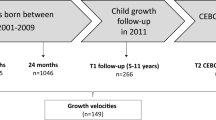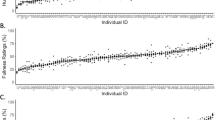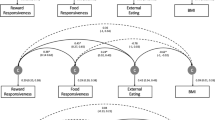Abstract
Background/Objectives
Reward-related eating is hypothesized to underlie risk for weight gain in obesogenic environments, but its role is unknown during pregnancy and postpartum when weight change is normative, but excess weight gain and weight retention are common. This study examined associations of self-reported reward-related eating, self-regulation, and the home food environment with excessive gestational weight gain (GWG) and postpartum weight change.
Subjects/Methods
Participants in the Pregnancy Eating Attributes Study observational cohort were enrolled at ≤12 weeks pregnancy and followed through 1-year postpartum (458 recruited; 367 retained through delivery). Participants completed four measures of reward-related eating—Modified Yale Food Addiction Scale, Power of Food Scale, Multiple Choice Procedure, and a Reinforcing Value of Food Questionnaire; two measures of self-regulation—Barratt Impulsiveness Scale and Delay of Gratification Inventory; and a Home Food Inventory. Measured weight and skinfolds were obtained. Multinomial logistic and multiple linear regression analyses estimated associations of reward-related eating, self-regulation, and home food environment with excessive GWG, gestational fat gain, postpartum weight change, and percent of GWG retained.
Results
Excessive GWG was associated with food reinforcement intensity, but not with any other measure of reward-related eating, self-regulation, or home food environment. Greater gestational fat gain was associated only with higher Multiple Choice Procedure. Postpartum weight change and percent of GWG retained were associated with greater delay of gratification and obesogenic home food environment, but not with any measure of reward-related eating or with impulsivity.
Conclusions
Findings do not support the hypothesis that self-reported reward-related eating is associated with weight outcomes in pregnancy and postpartum but indicate a relation of delay of gratification with postpartum weight retention. Further research using both surveys and objective measures of reward-related eating is needed to advance our understanding of the relation of reward-related eating with weight changes during this critical period of a woman’s life.
This is a preview of subscription content, access via your institution
Access options
Subscribe to this journal
Receive 12 print issues and online access
$259.00 per year
only $21.58 per issue
Buy this article
- Purchase on Springer Link
- Instant access to full article PDF
Prices may be subject to local taxes which are calculated during checkout
Similar content being viewed by others
References
Kominiarek MA, Peaceman AM. Gestational weight gain. Am J Obstet Gynecol. 2017;217:642–51.
Deputy NP, Sharma AJ, Kim SY, Hinkle SN. Prevalence and characteristics associated with gestational weight gain adequacy. Obstet Gynecol. 2015;125:773–81.
Johnson JL, Farr SL, Dietz PM, Sharma AJ, Barfield WD, Robbins CL. Trends in gestational weight gain: the Pregnancy Risk Assessment Monitoring System, 2000–2009. Am J Obstet Gynecol. 2015;212:806. e1–e8.
Siega-Riz AM, Herring AH, Carrier K, Evenson KR, Dole N, Deierlein A. Sociodemographic, perinatal, behavioral, and psychosocial predictors of weight retention at 3 and 12 months postpartum. Obesity. 2010;18:1996–2003.
Amorim AR, Rossner S, Neovius M, Lourenco PM, Linne Y. Does excess pregnancy weight gain constitute a major risk for increasing long-term BMI?. Obesity. 2007;15:1278–86.
Muktabhant B, Lawrie TA, Lumbiganon P, Laopaiboon M. Diet or exercise, or both, for preventing excessive weight gain in pregnancy. Cochrane Database Syst Rev. 2015:CD007145.
Michel S, Raab R, Drabsch T, Gunther J, Stecher L, Hauner H Do lifestyle interventions during pregnancy have the potential to reduce long-term postpartum weight retention? A systematic review and meta-analysis. Obes Rev. 2018;20:52–542.
Ziauddeen H, Alonso-Alonso M, Hill JO, Kelley M, Khan NA. Obesity and the neurocognitive basis of food reward and the control of intake. Adv Nutr. 2015;6:474–86.
Burger KS, Stice E. Elevated energy intake is correlated with hyperresponsivity in attentional, gustatory, and reward brain regions while anticipating palatable food receipt. Am J Clin Nutr. 2013;97:1188–94.
Volkow ND, Wise RA, Baler R. The dopamine motive system: implications for drug and food addiction. Nat Rev Neurosci. 2017;18:741–52.
Burger KS, Stice E. Neural responsivity during soft drink intake, anticipation, and advertisement exposure in habitually consuming youth. Obesity. 2014;22:441–50.
Demos KE, Heatherton TF, Kelley WM. Individual differences in nucleus accumbens activity to food and sexual images predict weight gain and sexual behavior. J Neurosci. 2012;32:5549–52.
Stice E, Spoor S, Bohon C, Veldhuizen MG, Small DM. Relation of reward from food intake and anticipated food intake to obesity: a functional magnetic resonance imaging study. J Abnorm Psychol. 2008;117:924–35.
Carr KA, Lin H, Fletcher KD, Epstein LH. Food reinforcement, dietary disinhibition and weight gain in nonobese adults. Obesity. 2014;22:254–9.
Flint AJ, Gearhardt AN, Corbin WR, Brownell KD, Field AE, Rimm EB. Food-addiction scale measurement in 2 cohorts of middle-aged and older women. Am J Clin Nutr. 2014;99:578–86.
Lemeshow AR, Rimm EB, Hasin DS, Gearhardt AN, Flint AJ, Field AE, et al. Food and beverage consumption and food addiction among women in the Nurses’ Health Studies. Appetite. 2018;121:186–97.
Cappelleri JC, Bushmakin AG, Gerber RA, Leidy NK, Sexton CC, Karlsson J, et al. Evaluating the Power of Food Scale in obese subjects and a general sample of individuals: development and measurement properties. Int J Obes. 2009;33:913–22.
Lipsky LM, Nansel TR, Haynie DL, Liu D, Eisenberg MH, Simons-Morton B. Power of Food Scale in association with weight outcomes and dieting in a nationally representative cohort of U.S. young adults. Appetite. 2016;105:385–91.
Berthoud HR, Morrison C. The brain, appetite, and obesity. Annu Rev Psychol. 2008;59:55–92.
VanderBroek-Stice L, Stojek MK, Beach SR, vanDellen MR, MacKillop J. Multidimensional assessment of impulsivity in relation to obesity and food addiction. Appetite. 2017;112:59–68.
Amlung M, Petker T, Jackson J, Balodis I, MacKillop J. Steep discounting of delayed monetary and food rewards in obesity: a meta-analysis. Psychol Med. 2016;46:2423–34.
Rollins BY, Dearing KK, Epstein LH. Delay discounting moderates the effect of food reinforcement on energy intake among non-obese women. Appetite. 2010;55:420–5.
Appelhans BM, Woolf K, Pagoto SL, Schneider KL, Whited MC, Liebman R. Inhibiting food reward: delay discounting, food reward sensitivity, and palatable food intake in overweight and obese women. Obesity. 2011;19:2175–82.
Epstein LH, Lin H, Carr KA, Fletcher KD. Food reinforcement and obesity. Psychological moderators. Appetite. 2012;58:157–62.
McCutcheon RA, Nour MM, Dahoun T, Jauhar S, Pepper F, Expert P, et al. Mesolimbic dopamine function is related to salience network connectivity: an integrative positron emission tomography and magnetic resonance study. Biol Psychiatry. 2019;85:368–78.
Fulkerson JA, Nelson MC, Lytle L, Moe S, Heitzler C, Pasch KE. The validation of a home food inventory. Int J Behav Nutr Phys Act. 2008;5:55.
Emery CF, Olson KL, Lee VS, Habash DL, Nasar JL, Bodine A. Home environment and psychosocial predictors of obesity status among community-residing men and women. Int J Obes. 2015;39:1401–7.
Nansel TR, Lipsky LM, Siega-Riz AM, Burger K, Faith M, Liu A Pregnancy eating attributes study (PEAS): a cohort study examining behavioral and environmental influences on diet and weight change in pregnancy and postpartum. BMC Nutr. 2016;2:45.
Centers for Disease Control and Prevention. National Health and Nutrition Examination Survey (NHANES) Anthropometry Procedures Manual. Centers for Disease Control and Prevention, Atlanta, GA, 2013.
IOM. Institute of Medicine (US) and National Research Council (US) Committee to Reexamine IOM Pregnancy Weight Guidelines.: Washington, DC: IOM; 2009. 3897.
Paxton A, Lederman SA, Heymsfield SB, Wang J, Thornton JC, Pierson RN Jr. Anthropometric equations for studying body fat in pregnant women. Am J Clin Nutr. 1998;67:104–10.
Lowe MR, Butryn ML, Didie ER, Annunziato RA, Thomas JG, Crerand CE, et al. The power of food scale. A new measure of the psychological influence of the food environment. Appetite. 2009;53:114–8.
Forman EM, Butryn ML, Juarascio AS, Bradley LE, Lowe MR, Herbert JD, et al. The mind your health project: a randomized controlled trial of an innovative behavioral treatment for obesity. Obesity. 2013;21:1119–26.
Yoshikawa T, Tanaka M, Ishii A, Watanabe Y. Immediate neural responses of appetitive motives and its relationship with hedonic appetite and body weight as revealed by magnetoencephalography. Med Sci Monit. 2013;19:631–40.
Epstein LH, Dearing KK, Roba LG. A questionnaire approach to measuring the relative reinforcing efficacy of snack foods. Eating Behav. 2010;11:67–73.
Koffarnus MN, Franck CT, Stein JS, Bickel WK. A modified exponential behavioral economic demand model to better describe consumption data. Exp Clin Psychopharmacol. 2015;23:504–12.
Griffiths R, JR Troisi I, Silvermian K, Miumford G. Multiple-choice procedure: an efficient approach for investigating drug reinforcement in humans. Behav Pharmacol. 1993;4:3–14.
Schmitz JM, Sayre SL, Hokanson PS, Spiga R. Assessment of the relative reinforcement value of smoking and drinking using a multiple-choice measurement strategy. Nicotine Tob Res. 2003;5:729–33.
Spinella M. Normative data and a short form of the Barratt Impulsiveness Scale. Int J Neurosci. 2007;117:359–68.
Hoerger M, Quirk SW, Weed NC. Development and validation of the delaying gratification inventory. Psychol Assess. 2011;23:725.
U.S. Census Bureau PD, Fertility & Family Statistics Branch. Current Population Survey: Definitions and explanations 2004 [Available from: http://www.census.gov/population/www/cps/cpsdef.html].
Vainik U, García-García I, Dagher A. Uncontrolled eating: a unifying heritable trait linked with obesity, overeating, personality and the brain. Eur J Neurosci. 2019;50:2430–45.
Bourdier L, Orri M, Carre A, Gearhardt AN, Romo L, Dantzer C, et al. Are emotionally driven and addictive-like eating behaviors the missing links between psychological distress and greater body weight? Appetite. 2018;120:536–46.
Pedram P, Wadden D, Amini P, Gulliver W, Randell E, Cahill F, et al. Food addiction: its prevalence and significant association with obesity in the general population. PLoS One. 2013;8:e74832.
Pursey KM, Collins CE, Stanwell P, Burrows TL. Foods and dietary profiles associated with ‘food addiction’ in young adults. Addict Behav Rep. 2015;2:41–8.
Holgerson AA, Clark MM, Ames GE, Collazo-Clavell ML, Kellogg TA, Graszer KM, et al. Association of adverse childhood experiences and food addiction to bariatric surgery completion and weight loss outcome. Obes Surg. 2018;28:3386–92.
Chao A, Grilo CM, White MA, Sinha R. Food cravings, food intake, and weight status in a community-based sample. Eating Behav. 2014;15:478–82.
Burger KS, Sanders AJ, Gilbert JR. Hedonic hunger is related to increased neural and perceptual responses to cues of palatable food and motivation to consume: evidence from 3 independent investigations. J Nutr. 2016;146:1807–12.
Lipsky LM, Nansel TR, Haynie DL, Liu D, Eisenberg Colman MH, Simons-Morton B. Lack of prospective relationships of the Power of Food Scale with Body Mass Index and dieting over 2 years in U.S. emerging adults. Eat Behav. 2019;34:101302.
Cushing CC, Benoit SC, Peugh JL, Reiter-Purtill J, Inge TH, Zeller MH. Longitudinal trends in hedonic hunger after Roux-en-Y gastric bypass in adolescents. Surg Obes Relat Dis. 2014;10:125–30.
Carpenter CL, Wong AM, Li Z, Noble EP, Heber D. Association of dopamine D2 receptor and leptin receptor genes with clinically severe obesity. Obesity. 2013;21:E467–73.
Vainik U, Neseliler S, Konstabel K, Fellows LK, Dagher A. Eating traits questionnaires as a continuum of a single concept. Uncontrolled eating. Appetite. 2015;90:229–39.
Davis C, Patte K, Curtis C, Reid C. Immediate pleasures and future consequences. A neuropsychological study of binge eating and obesity. Appetite. 2010;54:208–13.
Rasmussen EB, Lawyer SR, Reilly W. Percent body fat is related to delay and probability discounting for food in humans. Behav Processes. 2010;83:23–30.
Weller RE, Cook EW, Avsar KB, Cox JE. Obese women show greater delay discounting than healthy-weight women. Appetite. 2008;51:563–9.
Davies K, Wardle J. Body image and dieting in pregnancy. J Psychosom Res. 1994;38:787–99.
Blau LE, Lipsky LM, Dempster KW, Coleman MHE, Siega-Riz AM, Faith MSF, et al. Women’s experience and understanding of food cravings in pregnancy: a qualitative study in women receiving prenatal care at the University of North Carolina—Chapel Hill. J Acad Nutr Dietetics. 2019.
Yang Y, Shields GS, Wu Q, Liu Y, Chen H, Guo C Cognitive training on eating behaviour and weight loss: a meta-analysis and systematic review. Obes Rev. 2019;20:1628–41.
Kegler MC, Alcantara I, Haardorfer R, Gazmararian JA, Ballard D, Sabbs D. The influence of home food environments on eating behaviors of overweight and obese women. J Nutr Educ Behav. 2014;46:188–96.
Ledoux TA, Mama SK, O’Connor DP, Adamus H, Fraser ML, Lee RE. Home availability and the impact of weekly stressful events are associated with fruit and vegetable intake among African American and Hispanic/Latina Women. J Obes. 2012;2012:737891.
Nunnery DL, Labban JD, Dharod JM. Interrelationship between food security status, home availability of variety of fruits and vegetables and their dietary intake among low-income pregnant women. Public Health Nutr. 2018;21:807–15.
Patterson RE, Kristal AR, Shannon J, Hunt JR, White E. Using a brief household food inventory as an environmental indicator of individual dietary practices. Am J Public Health. 1997;87:272–5.
Gorin AA, Wing RR, Fava JL, Jakicic JM, Jeffery R, West DS, et al. Weight loss treatment influences untreated spouses and the home environment: evidence of a ripple effect. Int J Obes. 2008;32:1678–84.
Krukowski RA, Harvey-Berino J, West DS. Differences in home food availability of high- and low-fat foods after a behavioral weight control program are regional not racial. Int J Behav Nutr Phys Act. 2010;7:69.
Arumäe K, Kreegipuu K, Vainik U. Assessing the overlap between three measures of food reward. Front Psychol. 2019;10:883.
Price M, Higgs S, Lee M. Self-reported eating traits: underlying components of food responsivity and dietary restriction are positively related to BMI. Appetite. 2015;95:203–10.
Jensen CD, Duraccio KM, Carbine KA, Barnett KA, Kirwan CB. Motivational impact of palatable food correlates with functional brain responses to food images in adolescents. J Pediatr Psychol. 2017;42:578–87.
Rejeski WJ, Burdette J, Burns M, Morgan AR, Hayasaka S, Norris J, et al. Power of food moderates food craving, perceived control, and brain networks following a short-term post-absorptive state in older adults. Appetite. 2012;58:806–13.
Acknowledgements
Sources of Support: This research was supported by the Eunice Kennedy Shriver National Institute of Child Health and Human Development Intramural Research Program (contract #HHSN275201300012C and #HHSN275201300026I/HHSN27500002).
Author information
Authors and Affiliations
Corresponding author
Ethics declarations
Conflict of interest
The authors declare that they have no conflict of interest.
Additional information
Publisher’s note Springer Nature remains neutral with regard to jurisdictional claims in published maps and institutional affiliations.
Rights and permissions
About this article
Cite this article
Nansel, T.R., Lipsky, L.M., Burger, K. et al. Reward-related eating, self-regulation, and weight change in pregnancy and postpartum: the Pregnancy Eating Attributes Study (PEAS). Int J Obes 44, 2444–2454 (2020). https://doi.org/10.1038/s41366-020-00685-2
Received:
Revised:
Accepted:
Published:
Issue Date:
DOI: https://doi.org/10.1038/s41366-020-00685-2
This article is cited by
-
Associations of ultra-processed food intake with maternal weight change and cardiometabolic health and infant growth
International Journal of Behavioral Nutrition and Physical Activity (2022)
-
Prospective relations of maternal reward-related eating, pregnancy ultra-processed food intake and weight indicators, and feeding mode with infant appetitive traits
International Journal of Behavioral Nutrition and Physical Activity (2022)



